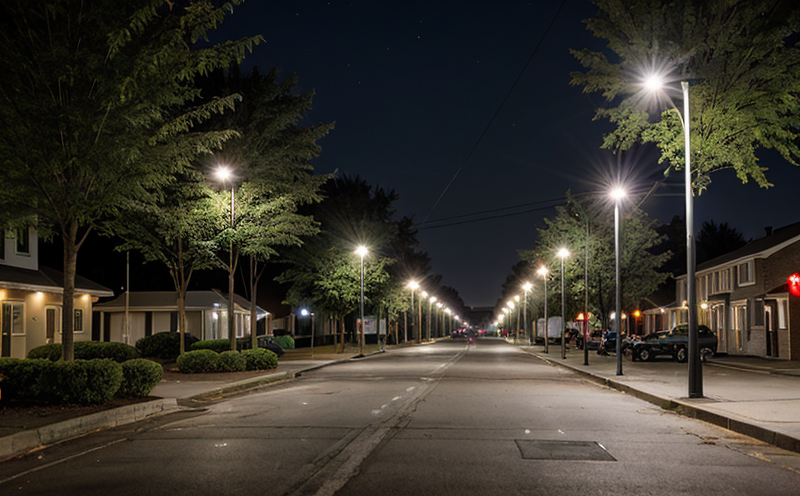IES LM 79 Outdoor Photometric and Electrical Testing of LED Luminaires
The IES LM-79 standard provides a method for photometric testing and measurement of luminaires. This service focuses on the outdoor application, ensuring that LED luminaires meet stringent standards for performance and compliance with international regulations.
Outdoor lighting is critical in providing safety and security to pedestrians and motorists alike. The IES LM 79 test ensures that these luminaires are not only highly efficient but also reliable under real-world conditions. This testing process involves measuring the optical power distribution of the luminaire over time, which includes both photometric and electrical aspects.
The standard is widely used by lighting manufacturers to ensure their products meet the necessary requirements for energy efficiency, quality, and safety. By conducting this test, we can verify that the luminaires comply with these standards, thus providing a high level of confidence in product performance.
During testing, we follow all relevant international standards such as IES LM-79 to ensure accuracy and consistency. The process involves measuring various parameters including lumen maintenance, power factor, efficacy, and more. This data is used to determine the overall efficiency and durability of the luminaire under different operating conditions.
The testing procedure ensures that all components are tested in an environment that simulates real-world use cases. For instance, we subject the luminaires to temperature cycling tests to assess their performance over a wide range of temperatures. This helps us understand how well they will perform in various weather conditions and environments.
We also conduct electrical testing to ensure compliance with safety regulations. This includes checking for insulation resistance, ground fault current, and other critical parameters. These tests are crucial in preventing potential hazards that could arise from improper design or manufacturing practices.
The results of these tests provide valuable insights into the performance characteristics of the luminaire. They help manufacturers make informed decisions about product improvements and enhancements. Additionally, they serve as proof points for regulatory compliance and marketing purposes.
Scope and Methodology
| Parameter | Description |
|---|---|
| Lumen Maintenance | Measures the luminaire's ability to maintain its light output over time. |
| Power Factor | Evaluates how effectively the luminaire converts electrical power into useful light. |
| Efficacy | Determines the ratio of luminous flux produced by a lamp to the electrical power input. |
| Thermal Cycling | Tests the luminaire's performance under varying temperature conditions. |
| Electrical Safety | Checks for potential safety hazards such as insulation resistance and ground fault current. |
The testing process begins with thorough preparation of the specimen. This includes cleaning, labeling, and ensuring all components are in optimal condition prior to testing. Once prepared, we proceed with photometric measurements using a calibrated photometer. These measurements provide detailed information about the light distribution pattern of the luminaire.
Electrical parameters such as current, voltage, and power factor are also measured simultaneously. This allows us to evaluate the overall efficiency and performance of the luminaire under various operating conditions. After completing these initial tests, we subject the luminaire to thermal cycling to simulate real-world environmental stressors. Finally, electrical safety checks are conducted to ensure compliance with relevant standards.
The data collected during testing is then analyzed using specialized software tools. This analysis provides us with a comprehensive understanding of the luminaire's performance characteristics and helps identify any areas for improvement. The final report summarizes all findings and recommendations based on our analysis.
Benefits
The benefits of IES LM 79 outdoor photometric and electrical testing are numerous. Firstly, it ensures that the luminaires meet stringent performance requirements set by international standards. This enhances consumer confidence in purchasing these products. Secondly, it helps manufacturers identify any issues early on in the development process, allowing for timely corrections.
Thirdly, compliance with these tests can lead to reduced costs associated with product recalls and returns. Additionally, successful completion of these tests opens up new market opportunities by demonstrating high-quality standards to potential clients. Lastly, it contributes towards sustainable practices by promoting energy-efficient lighting solutions which contribute positively towards reducing carbon footprints.
In summary, IES LM 79 outdoor photometric and electrical testing is essential for ensuring product quality, enhancing customer satisfaction, minimizing operational expenses, creating competitive advantages, supporting sustainable development goals, and meeting regulatory requirements. These benefits make it an indispensable service in the field of LED luminaire manufacturing and installation.
Why Choose This Test
Choosing IES LM 79 outdoor photometric and electrical testing offers several advantages over other methods. Firstly, it provides comprehensive coverage of both photometric and electrical aspects of luminaires, giving a holistic view of their performance. Secondly, the use of internationally recognized standards ensures consistency across different markets.
Thirdly, this testing method is designed to simulate real-world conditions, making it more reliable than laboratory tests conducted under controlled environments. Fourthly, it helps manufacturers comply with regulatory requirements, avoiding costly penalties and legal issues.
Fifthly, the detailed reports generated from this test can be used for marketing purposes, enhancing brand reputation and attracting potential customers. Sixthly, it promotes sustainable practices by encouraging energy-efficient lighting solutions which are beneficial for both the environment and society at large.
In conclusion, selecting IES LM 79 outdoor photometric and electrical testing is a wise decision given its numerous advantages. It not only ensures product quality but also provides valuable insights into performance characteristics that can be used to improve future generations of products.





